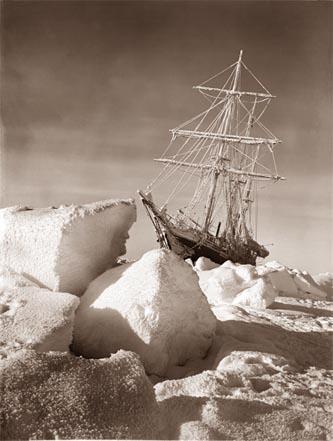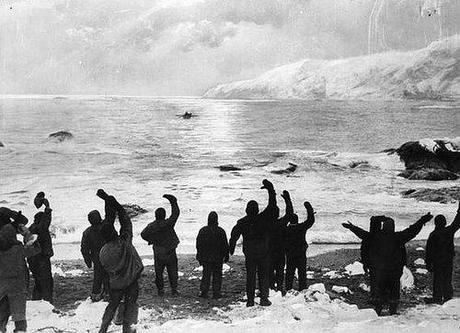 100 hundred years ago this month, Ernest Shackleton and his crew of 27 men, set out from Plymouth in the U.K. aboard their ship, the Endurance. Their destination was Antarctica, where Shackleton and his team hoped to become the first men to make a land crossing of the frozen continent. But fate had other plans for the veteran polar explorer and his men. That crossing would never take place, and they would soon find themselves in a fight for survival that seems hard to believe, even a century after it took place.
100 hundred years ago this month, Ernest Shackleton and his crew of 27 men, set out from Plymouth in the U.K. aboard their ship, the Endurance. Their destination was Antarctica, where Shackleton and his team hoped to become the first men to make a land crossing of the frozen continent. But fate had other plans for the veteran polar explorer and his men. That crossing would never take place, and they would soon find themselves in a fight for survival that seems hard to believe, even a century after it took place.To celebrate the 100th anniversary of the Endurance Expedition, an organization called Shackleton 100 is organizing a series of events that will commemorate the historic journey. Over the next two years, the group will recognize some of the major milestones that occurred on the expedition. The first of those events was a re-enactment of the launch of the Endurance a century earlier.
It would take weeks for the Endurance to reach the Southern Ocean, with the ship and her crew reaching South Georgia Island, where they resupplied and sent back word of their progress, before proceeding onward. They left the island on December 5, 1914, and approached the Antarctic continent soon there after. Heavy ice slowed progress for a time, but they pressed forward. Shackleton was eager to begin the traverse, as it was summer in the Southern Hemisphere. But on January 19, 1915, the ship became stuck in the ice, completely surrounded, and unable to move in any direction. Disaster had struck.
Shackleton and his crew stayed aboard the Endurance, for a few weeks before he realized that the only way the ship would break free would be to wait for the spring thaw. That was still months away, so in February, the crew disembarked from the ship, and set up a temporary base on the ice flows. There they stayed through the long Antarctic winter, waiting for someone to come rescue them, or for their own ship to break free from the ice at last.
It would be September before the thaw would begin, but the pressure that the shifting ice placed on the Endurance was too much. On October 24, her hull was breached, and it soon became clear that the ship was lost. All of the supplies for the expedition were offloaded onto the ice, and on November 21, the vessel sunk beneath the surface. The men truly were stranded, hundreds of miles from the closest human settlement.
The crew of the Endurance stayed on the ice for nearly two months, hoping that it would flow close enough to Paulet Island that they could retrieve a supply cache that they had left there. But the Southern Ocean wasn't cooperating, and thick ice continued to block their way. Forced to move their base of operations to another ice flow, and set up a camp called "Patience," the men continued to wait, but in April of 1916 that ice flow began to break apart, and Shackleton ordered his men into lifeboats. They survived five long, and very difficult, days at sea, crossing nearly 350 miles (560 km) of open ocean, before landing on the remote Elephant Island, exhausted and without hope.
Knowing that their supplies were running low, and that Elephant Island was far from the shipping lanes, Shackleton made a bold move to try to find help. Taking just five men, he took one of the lifeboats, and set off on an open-water crossing of the Southern Ocean in an attempt to reach South Georgia, where a whaling station was maintained year round. It took 15 days to cover the 800 nautical miles (1480 km) to reach the island, and when they did, the men were on the wrong side. Rather than risk returning to the sea, Shackleton, along with two of his men, force marched for 36 hours, covering 32 miles over very rough terrain to reach the whaling station, and the help they were desperately searching for. That was on May 20, 1916.
 Fearing for the safety of his men still on Elephant Island, Shackleton immediately went to work organizing a rescue. But, just like everything else on this expedition, it didn't go as planned. Heavy ice blocked the approach to the island, and it took three tries before a ship was able to locate the crew of the Endurance. They were rescued on August 30, more than two years after they had set sail from Plymouth.
Fearing for the safety of his men still on Elephant Island, Shackleton immediately went to work organizing a rescue. But, just like everything else on this expedition, it didn't go as planned. Heavy ice blocked the approach to the island, and it took three tries before a ship was able to locate the crew of the Endurance. They were rescued on August 30, more than two years after they had set sail from Plymouth.Through this entire ordeal, Shackleton remained steadfast in his leadership, and always looked out for the safety of his men. After all they had been through – the loss of they their, ship, living for months on the ice, the long ocean crossings, the lack of supplies, etc. – not a single member of the crew was lost. That is a fact that continues to amaze me to this day.
Shackleton and his men returned to a world that they could barely recognize. When they had set out on their expedition in August of 1914, a war was on the verge of breaking out in Europe. The predominant feeling at the time was that it wouldn't last long, and that life would return to normal in a matter of months. That conflict escalated into the first World War, and in 1916 a stalemate of sorts was underway. By that point, millions of lives and been lost, as new weapons of mass destruction, including poison gas, flame throwers, and machine guns, were introduced on the battlefield for the first time. Europe was in chaos, and madness had gripped a world of sanity that Shackleton and his crew had left behind.
Many of the men would recover from their ordeal, only to be pressed into service in the war. Some of them would not survive. Shackleton himself volunteered for duty, and requested an assignment in France. He was denied that request, and was instead sent to South America in an attempt to rally other countries to help fight the war. It was a job he was ill suited for.
After the war, he went on the lecture circuit, and later organized one last expedition to the Antarctic. During that final voyage, Shackleton suffered a fatal heart attack and died. He is buried on South Georgia Island today.
The Shackleton 100 group plans to commemorate all of these milestones, and more, in the weeks and months ahead. You can find a full calendar of events on the organization's website, with a schedule that runs through October of 2016.
As I've said before, Shackleton's story is perhaps the greatest survival story of all time, and I definitely feel it is one that should be retold for a generation that probably knows little about this famously doomed expedition. Hopefully, the efforts of the Shackleton 100 will help share that story.

